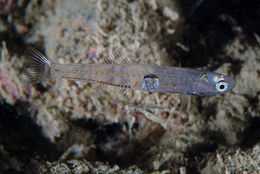Transparent goby
| Transparent goby | |
|---|---|
 | |
| Conservation status | |
| Not evaluated (IUCN 3.1) | |
| Scientific classification | |
| Kingdom: | Animalia |
| Phylum: | Chordata |
| Superclass: | Osteichthyes |
| Class: | Actinopterygii |
| Subclass: | Neopterygii |
| Infraclass: | Teleostei |
| Superorder: | Acanthopterygii |
| Order: | Perciformes |
| Suborder: | Gobioidei |
| Family: | Gobiidae |
| Subfamily: | Gobiinae |
| Genus: | Aphia A. Risso, 1827 |
| Species: | A. minuta |
| Binomial name | |
| Aphia minuta (A. Risso, 1810) | |
| Synonyms | |
|
For genus Aphia:
For Species Aphia minuta:
| |
Aphia minuta, the Transparent goby, is a species of the goby native to the northeastern Atlantic Ocean where it can be found from Trondheim, Norway to Morocco. It is also found in the Mediterranean, Black Sea and the Sea of Azov. It is a pelagic species, inhabiting inshore waters and estuaries. It can be found at depths of from the surface to 97 metres (318 ft), though it is usually found at 5 to 80 metres (16 to 262 ft), over sandy and muddy bottoms and also in eel grass beds. This species can reach a length of 7.9 centimetres (3.1 in) TL. It is an important species to local commercial fisheries. It is currently the only known member of its genus.[1]
Gastronomy
This fish is appreciated in Spain as part of the Andalusian, Catalonian and Valencian cuisines.[2] In Andalusia, where they are called chanquetes it is traditionally served deep-fried, with fried eggs and roasted or fried pepper.[3] Due to its rarity and high prize, it is being commercially replaced by some species of Chinese noodlefishes, locally called chanquete chino (Chinese chanquete), Neosalanx tangkahkeii and Protosalanx hyalocranius.[4]
External links
References
- ↑ Froese, Rainer and Pauly, Daniel, eds. (2013). "Aphia minuta" in FishBase. April 2013 version.
- ↑ "Chanquete". Euroresidentes.com. Retrieved 2014-08-17.
- ↑ "Chanquetes fritos con pimientos, cebolla y huevo frito". Mis-recetas.org. Retrieved 2014-08-17.
- ↑ "East China Seas Holdings Corporation Ltd. - ECS". Eastchinaseas.com. Retrieved 2014-08-17.